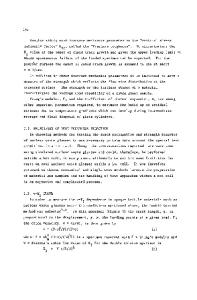The Mechanisms for Hydrothermal Leaching of Nuclear Waste Glasses: Properties and Evaluation of Surface Layers
- PDF / 3,356,526 Bytes
- 12 Pages / 417.6 x 639 pts Page_size
- 44 Downloads / 290 Views
THE MECHANISMS FOR HYDROTHERMAL LEACHING OF NUCLEAR WASTE GLASSES: PROPERTIES AND EVALUATION OF SURFACE LAYERS
G[NTER MALOW Hahn-Meitner-Institut fOr Kernforschung Berlin GmbH.,
Glienicker StraBe 100, D 1000 Berlin 39
INTRODUCTION Remobilization of solidified high-level waste by corrosion and transport of radionuclides by groundwater are the only likely events for radioactivity to find its
way back to the environment. The interaction of the waste form with
aqueous solutions is
the most important mechanism and must be known for safety
and risk analysis. It
has been shown that the activity release depends on a num1 The corrosion mechanisms of
ber of experimental and environmental parameters.
the waste forms control the leach rate of individual components.
Of particular
importance to the resistance against water attack of various glass compositions is
the formation of layers on the glass surface.2 The results for leaching in
deionized water reveafed that the mechanism was strongly influenced by the formation of a surface layer which determined the further attack on the glass.3 In this work the specific weight losses of the glass after leaching in rock salt and MgCl
2 -MgSO 4 -NaCl-KCl
solutions were measured and surface layers investi-
gated.
EXPERIMENTAL The borosilicate glass C-31 3EC containing 20 w/o LWR-type 4 5 simulated waste oxides was investigated. '
(30.000 MWd/tHM
Glass beads were used for hydrothermal leaching experiments having size and shape comparable to beads which will be produced in the German prototype vitri6 fication plant PAMELA. The German final repository concept foresees the waste disposal in
salt for-
mations.
Present model calculations of heat release from HLW glass blocks com7 prize temperatures up to 2000C at the canister/salt interface. The compositions of the leachants ence and experiments.
5
(brines) can be derived from mining experi-
Compositions of the brines for 55 C used in this work are given in table 1. Glass beads were leached in Teflon lined autoclaves at 200°C at equilibrium pressure,
i.e. n
15 bar in
saturated salt solutions.
26
Hydrothermal leaching experiments in pure water revealed a volume and time dependency of the specific weight loss which seems to disappear at about 300 ml solution and 10 d resp.3
Therefore,
300 ml stagnate salt solutions and leaching
periods up to 30 d were applied. After leaching,
specific weight losses were determined and the leached sur-
faces were investigated by X-ray diffraction, and Electron Probe Microanalysis
Scanning Electron Microscopy
(SEM)
(EPMA).
TABLE 1 COMPOSITIONS OF SALT SOLUTIONS (AFTER J.D'ANS, "DIE LOSUNGSGLEICHGEWICHTE DER SYSTEME DER SALZE OZEANISCHER SALZABLAGERUNGEN", BERLIN 1933)
System
0
Point
Mole per 1000 Mole H20 (T = 55 C) NaCl 113.4
NaCI-H 20
KCI
MgC1 2
MgSO 4
-
-
-
Quinary System
2
1.0
2.6
111.2
2.1
NaCI-KC1MgC1 2 Na 2 SO4 -H 2 0
Q
6.8
17.4
77.3
3.2
RESULTS AND DISCUSSION Specific weight loss measurements The results of some preliminary leaching experiment
Data Loading...











